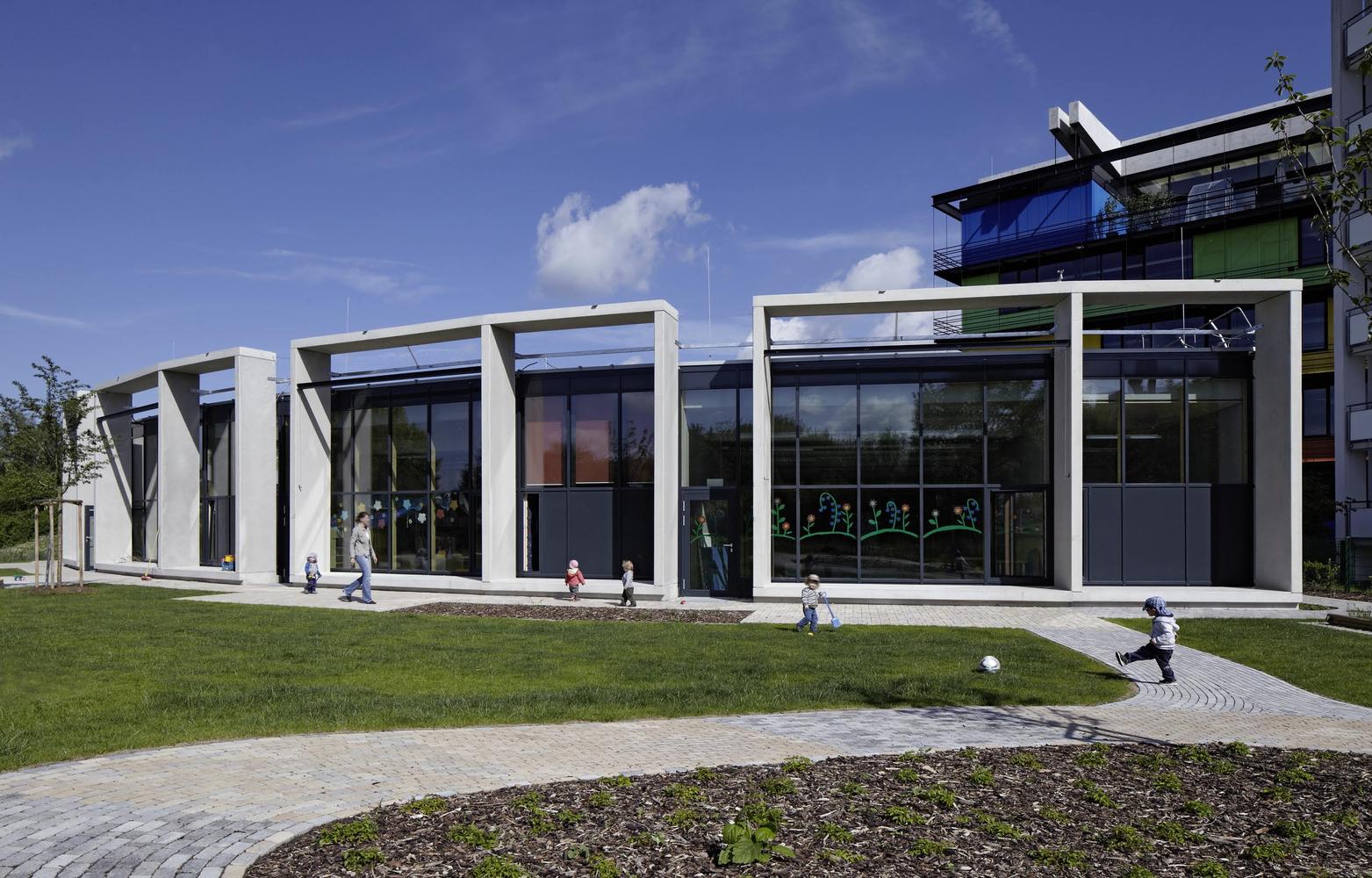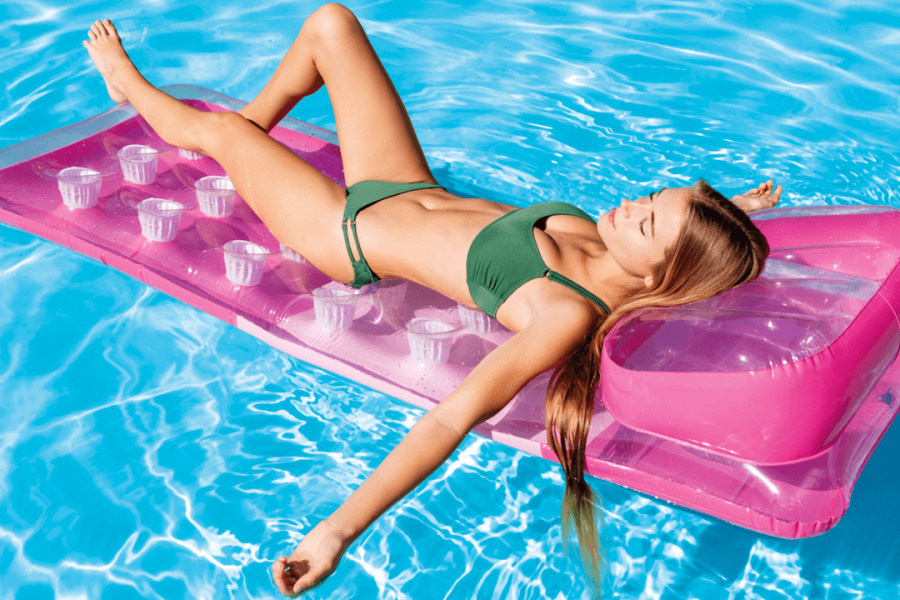Today, future kindergarteners are registered on an electronic waiting list and, fortunately, now you can choose the kindergarten that you like the most in terms of teaching staff and the best conditions for children, and not just in terms of the area.
Some parents are immediately the luckiest of all - they can take their child to one of 20 unique creative kindergartens.
1. Sjötorget Kindergarten, Stockholm, Sweden

Designed by the reputable Rotstein Arkitekter, this kindergarten is located on the ground floor of a new building in a prestigious area of Stockholm. The playful design, according to the creators, helps to reveal children's talents, develop creativity and promote a friendly and cozy atmosphere. The entrance to the kindergarten is located in the center of the building, the rooms have many windows - of different formats and sizes, which provides an abundance of natural light and, of course, gentle sunlight. By the way, it was not for nothing that the Swedes came up with this: it is known that the sun is a rare guest in this northern country, so each time it appears is a real holiday for the kids. A large number of windows, just guarantees that the children will not miss it, having lunch or studying with teachers in the classrooms.
Sjötorget Kindergarten is decorated in the most positive colors, which, according to Rotstein Arkitekter, lift the mood, have a beneficial effect on the child's psyche, improve the learning process and even promote healthier sleep. Just look: green, yellow, pink, lots of white space - it is simply impossible to look at this interior without smiling! And so that the kids can have fun here, the designers came up with original glazed niches in which they can read books, play hide-and-seek or just chat with friends, as well as many massive stairs and steps, which you can run up and down all day long. Completely safe. Everything here is soft and there are no sharp corners.
2. Garden by Eva Samuel Architec, Paris

In the strict urban area of Olympiades, this wonderful kindergarten looks like a bright toy or candy in a festive wrapper, among impregnable concrete blocks and glass towers. Built in the 1960s, this garden was reconstructed by the Eva Samuel Architec bureau, who turned it into a real children's dream! In addition to a pleasant design, the team of architects faced the task of making the garden compact and at the same time placing a swimming pool, bowling alley, as well as creating cozy rooms with natural light, a dining room, playrooms and classrooms. And they succeeded in this with a big 5 plus. In creating the interior, natural materials were used as much as possible - for example, wood, which covered the floor, partially the walls and ceilings. The raspberry color acts as a bright accent and in combination with wood creates a warm and cozy atmosphere.
3. Barbapapà Kindergarten, Vignola, Italy

The kindergarten project was developed by the architectural and design bureau ccd studio, which won the city tender for construction in 2006. The kindergarten itself was built in 2009 and is designed for 4 classes and 60 children in total. The building is located on the edge of the urban development, in a picturesque area on a hill, not far from the historical center of Vignola. The welcoming green lawns of the courtyard hospitably welcome preschoolers and allow them to enjoy playing in the fresh air. The roof windows in all the rooms are designed so that sunlight enters the rooms at different times of the day, and the children always smile at its gentle rays. The roof of the kindergarten is equipped with solar panels that provide electricity to the entire building, and special reservoirs that collect rainwater allow it to be purified and used in the household. In addition, the kindergarten has its own spacious stadium for active pastime, sports games and competitions.
4. Kensington International Kindergarten, Bangkok, Thailand

This wonderful garden is located in Bangkok, the capital of Thailand, and is a perfect combination of play space and architectural minimalism. Designed by Plan Architect, the garden is created in such a way as to maximally develop children's imagination and creativity: transparent walls, curved, bent glass that acts as thin partitions between children's rooms and the street, the absence of any sharp corners - all this also allows children to admire nature, which is particularly exotic here. Pay attention to the thoughtful exterior: in addition to lawns, toys and recreation areas, there is also a demarcated roadway, where kinder kids can safely ride mobiles or bicycles.
5. Design Kindergarten, Wonslid, Denmark

The ultra-modern Design Kindergarten, designed by CEBRA, is designed in such a way that children, being there every day, would curiously explore the building and premises, thus developing their inquisitive mind and creative potential. Interestingly, parents took an active part in the design of the kindergarten, offering their creative ideas, some of which CEBRA adopted and implemented in this project. Based on the philosophy of the developers, the kindergarten should teach children only with its exterior and interior: the process of development and learning should be continuous:
"THE USE OF THE BUILDING SHOULD BE USEFUL FOR THE CHILDREN'S MIND, AND THAT'S WHY WE INTENTIONALLY AVOID TEMPLATES AND CLICHES IN THE IMPLEMENTATION OF THE KINDERGARTEN PROJECT. CHILDREN SHOULD UNDERSTAND THAT A HOUSE SHOULD NOT LOOK THE WAY THEY ARE USED TO IMAGINE IT: WITH A TRIANGULAR ROOF, A RECTANGULAR DOOR AND SQUARE WINDOWS. WE BREAK TEMPLATES! WE TEACH CHILDREN TO THINK CREATIVELY, OUT OF THE STANDARD! OUR BUILDING HAS A JAGGED ROOF, IT HAS NO ANGLES, ALMOST ALL THE WALLS HERE ARE SMOOTH. “THE KINDERGARTEN IS DIRECT PROOF THAT ANY HOUSE CAN BE AS YOU IMAGINE IT. YOU JUST HAVE TO TURN ON YOUR IMAGINATION,” THEY EXPLAIN AT CEBRA.
6. COBY Kindergarten, Tokyo, Japan

Designed by the trendy Japanese firm Tsushima Design Studio, the COBY Kindergarten combines modern design, minimalism and compactness, as well as multifunctionality with an emphasis on the exterior, which the designers designed in such a way that children can spend time outdoors with pleasure and benefit (just look at the luxurious garden surrounding COBY Kindergarten!). Inside the kindergarten, all spaces are closely interconnected and open: children can watch their lunch or dinner being prepared even from the second floor, where the classrooms are located.
7. Kindergarten in Terenten, Italy

It is hard to imagine a more picturesque location for a kindergarten than the mountain village of Terenten in South Tyrol, Italy! This region is a border zone, a territory dividing three cultures, which is visually reflected in the building of the kindergarten. According to the idea of the architects from feld72, the garden combines modern multifunctionality, fashionable design and some traditional motifs (use of natural materials, decoration and interior elements), which are flawlessly integrated into the impressive mountain landscape. The kindergarten is built on the site of a former golf course, located next to a primary school, which visually makes up an organic architectural ensemble. The complex is equipped with a modern gym, where children are engaged in various types of fitness - for example, dancing and yoga. Lots of space for active games, kid-friendly warm design with bright light green elements, sunlight, creative niches and stairs, windows and steps, terraces and courtyards, classrooms equipped with the latest technology - all this makes the kindergarten truly one that our children would love to go to!
8. Kindergarten 8Units, Velez-Rubio, Spain

The goal of this project is to develop psychomotor skills, as well as the mental and social development of each child attending the 8Units kindergarten. According to the idea of the LosdelDesierto design bureau, the kindergarten should become a second home for the kids. Guided by this, the team of the bureau created a bright and compact, maximally comfortable for children one-story HOUSE with large windows, a sloping roof, round porthole windows with multi-colored glass and the most creative interior, in which children feel like fish in water. Everything here is arranged in such a way that in the midst of the game, the little ones could not get injured: soft vinyl floor, rounded walls and the absence of sharp corners.
"IF WE TALK ABOUT CHILDREN 3+, THEY SHOULD BE PLAYING A LOT. COLOR PLAYS A VERY IMPORTANT ROLE AT EARLY AGE. OUR SON USED COLOR TO ASSEMBLE PUZZLES AND BUILD A SENTENCE. UNDERSTANDING THIS, WE DECIDED TO SELECT THE RIGHT COLOR COMBINATION FOR EVERY AGE," SAYS THE FOUNDER OF LOSDELDESIERTO.
For one-year-old children - rooms in blue, symbolizing relaxation, sea, dreams, for children from 1 to 2 years old - rooms are painted orange, which stimulates psychomotor skills and activity, for children from 2 to 3, green was chosen, which, as is known, is the color of nature. Common areas are a mix of colors, which is also very symbolic, because our society, and the world as a whole, is bright, colorful and so diverse!
9. Kindergarten Kita Göttingen, Göttingen, Germany

This kindergarten is an example of how to build the most energy-efficient eco-houses. Kita Kindergarten is completely self-sufficient in electricity. Its walls are designed in such a way that they minimize heat loss, keeping it indoors, but at the same time allowing fresh air to circulate freely in the space. Stylish, thoughtful design makes the kindergarten cozy and comfortable for children, where they enjoy spending time from early morning until late evening. Note: here, as in the previous buildings, there are large dormer windows, thanks to which sunlight is present in the building at any time of the year.
10. Kindergarten in Jakarta, Indonesia

In the progressive district of Jakarta — Bintaro Jaya, there is one of the best kindergartens in the world. With a small budget, the Djuhara + Djuhara bureau managed to create a truly modern kid-friendly building with a pleasant, trendy interior. Using natural materials from nearby villages, the designers made the garden as eco-friendly as possible: there is a lot of natural light, greenery, wood, open terraces for games, wicker furniture and other interior elements created by the hands of folk craftsmen from small and even family workshops. Light spacious rooms, bright colors in the interior, interspersed with the calm of warm wood, harmoniously located play areas and study rooms, a dining room and bedrooms - all this makes the kindergarten welcoming and one where you will not have to take your child with tears in your eyes and shouts of "I don't want it!"
11. Ecole Maternelle Pajol, Paris, France

The creators of this rainbow territory for children decided that the kindergarten's appearance should correspond to the child's mood - bright, cheerful, radiating optimism. After all, even dreams in childhood are colorful!
“We love color, especially when it is used to brighten and brighten up a gray and dull environment,” say the creators of the “rainbow” garden. “And this kindergarten definitely speaks the language of joyful colors. We love when public art, public buildings and spaces are used for play, for expressing joy, and not just for displaying “acceptable” art and architecture. And shouldn’t a kindergarten be in tune with the mood of children, not adults?”
You understand that the education in this kindergarten is not “wrapped up” by the standards of the adult picture of the world. All the best is for the children!
12. Fuji Kindergarten, Tokyo, Japan

Perhaps this kindergarten can be called the most environmentally friendly. If only because it was built (or rather, one of the buildings of the kindergarten) around a tree! The ring around the tree, according to the designers, activates the energy of nature, which in its charge is very similar to a lively and wild nursery. The design is chosen so that young kindergarteners are open to learning about the world, which opens up before us at 360 degrees.
13. Taka-Tuka-Land, Berlin, Germany

The creators of the Berlin kindergarten Taka-Tuka-Land took one truth into account: all children must be active for normal development. They rush back and forth at breakneck speed – and it is in this high-speed format that they best absorb all the wisdom of the world. So there is no need to pull them back and insure them against falls and bruises. It is better to create conditions so that the “perpetual motion machines” can move without fear. Said and done: as a result, there are practically no hard surfaces in Taka-Tuka-Land. Well, maybe the floor and corners of the rooms.
By the way, the name of the kindergarten comes from the ideal country for children Taka-Tuka from the fairy tale about Pippi Longstocking. The entrance to the kindergarten is designed as a giant hut, inside of which there are many more huts and trampolines. And what Swedish walls there are! They are not nailed to the walls, but are assembled into entire towns of ladders, arches and swings.
14. Kekec Kindergarden, Ljubljana, Slovenia

The architects of this kindergarten openly believe that the most important place in the garden is the playgrounds. They should be spacious - one, and there should be a lot of them - two.
Now, even the façade of an unusual garden in Ljubljana is a playful element in itself. On one side, the boards that cover the glass façade are painted in bright colors, while on the other, the wooden surface remains natural. What's the trick?
And the fact is that on the one hand it creates shade, on the other hand, children play with the shutters, learn colors and can change the “appearance” of their kindergarten themselves.
15. Segrt Hlapic, Zagreb, Croatia

Why create a complex structure for children to walk and wander through the corridors?
The architects of Radionica Arhitekture, who created the Zagreb dream kindergarten, took a risk and built a large, elongated building, where each group of children has access to a huge, spacious room – and in it, a bedroom, a playroom, and a classroom. All inclusive!
16. Fagerborg Kindergarten, Oslo, Norway

Norwegians – both young and old – obey the Jante Law, according to which everyone is equal and should not stand out in a team. This explains the democratic and ecological project, with very positive “content” and interiors made of natural wood.
And so that the children – they are children! – don’t get bored, the wooden facades alternate with bright, cheerful inclusions in the most unexpected places.
17. Kindergarten 70°N arkitektur as, Tromsø, Norway

Another Norwegian "unique" - holes of different sizes are made in the walls of the rooms, through many of which children can easily crawl.
Educators can also squeeze through them – this makes it much easier to keep an eye on the little “shilovpops” and keep an eye on everyone at once.
Moreover, some internal walls can be moved, that is, the space can be changed to suit your needs.
18. Aadharshila Vatika, New Delhi, India

In India, children are always smiling, so the designers of the capital's children's center decided to reflect in their project the importance of optimism and fun in the development of a young inquisitive child, who needs to be taught how to navigate.
To this end, a unique atmosphere has been created here, filled with bright colors and unusual furniture, as well as elements that will help to better understand how vast and diverse the world is. On the surfaces of the floors and walls inside and outside the building, they placed graphic signs, traces of rails, and Braille.
19. Loop Kindergarten, Tianjin, China

In the most populous country in the world there is a kindergarten created in the shape of... a "donut".
It has rounded edges, a roof with green grass, lots of windows and splashes of bright colors that create the illusion of movement for fidgets, thereby helping to develop imagination.
20. Kindergarten Wolfartsweier, Karsruhe, Germany

Our favorite kindergarten, created in the shape of a cat, which seems to be ready to jump. In the morning, the kids enter the "mouth" on a red carpet-tongue, like obedient mice. Inside the "paws" of the cat there are playgrounds, and in its "belly" there is a changing room, a classroom for classes, a kitchen, a dining room and a staircase.
The second floor is the “head”, where there is a hall where light penetrates through the eye-socket windows during the day, and real grass grows on the roof – the cat’s “fur”.












